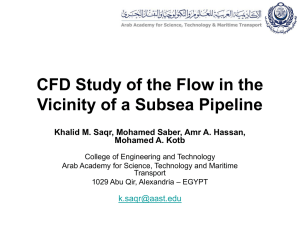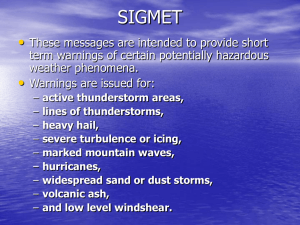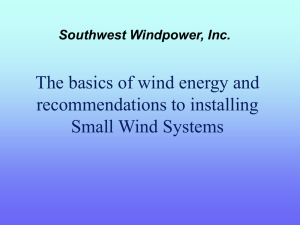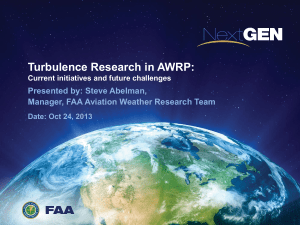Local Formulations for Turbulence Models
advertisement
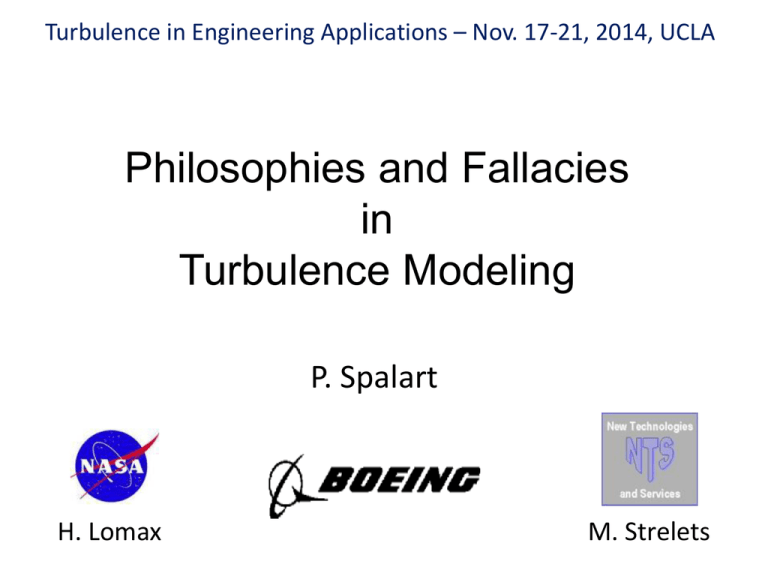
Turbulence in Engineering Applications – Nov. 17-21, 2014, UCLA Philosophies and Fallacies in Turbulence Modeling P. Spalart H. Lomax M. Strelets Turbulence in Engineering Applications – Nov. 17-21, 2014, UCLA Companion Article • Paper with same title – To be submitted to Progress in Aerospace Sciences – Soon… • This talk: – Has the same structure – Covers only a subset of the Fallacies • (but lists them all) Turbulence in Engineering Applications – Nov. 17-21, 2014, UCLA Outline • Fundamental paradox of turbulence modeling – What does a Reynolds stress mean? – Do/should models have local formulations? • Philosophies of modeling – Systematic philosophy – Openly empirical philosophy • Fallacies of modeling – Hard fallacies – Intermediate Fallacies – Soft Fallacies • Underlying assumptions in turbulence modeling Turbulence in Engineering Applications – Nov. 17-21, 2014, UCLA Fundamental Paradox • Reynolds (time) averaging defines Reynolds stresses: • The mean velocity Ui and stress <uiuj> “exist” locally at (x,y,z) Vorticity and mean streamlines Average Turbulence in Engineering Applications – Nov. 17-21, 2014, UCLA Character of Vortex Shedding by Cylinder • The lift signal has considerable modulations • Phase averaging cannot be justified Turbulence in Engineering Applications – Nov. 17-21, 2014, UCLA Motivation for Fully Time-Averaged Approach • Some systems have very small components Turbulence in Engineering Applications – Nov. 17-21, 2014, UCLA Flows with “not as Obviously Disparate” Eddies • A boundary layer at high Reynolds number has a very large number of similar eddies • Is Reynolds averaging now “natural?” Should RANS work well? DNS of the Ekman layer by R. Johnstone, U. of Southampton Turbulence in Engineering Applications – Nov. 17-21, 2014, UCLA Local Formulations for Turbulence Models • Classic non-local model: the algebraic model – Outer model in boundary layer nt = 0.02 Ue d* f(y/d) – Inner model mixing lengthVan Dreist l = k y ( 1 - exp(-yut/[26n]) ) • Modern RANS models avoid ut, and even more Ue, d* and d • Two reasons to prefer a local model: – Convenience in a CFD code – Physics (see below) • There are intermediate levels of locality: – Use of the wall distance d, or wall-normal vector n – Both are pre-calculated. n is discontinuous – Both should make the term “dormant” in free shear flows • In view of Fundamental Paradox, the physics of the locality preference are debatable – Even local models are tested only in large mature regions of turbulence – Sub-regions are coupled by history, transport and diffusion terms • In incompressible flows, pressure is a “non-local” quantity Turbulence in Engineering Applications – Nov. 17-21, 2014, UCLA Local and Non-Local Quantities Field point d d, or y n Wall Turbulence in Engineering Applications – Nov. 17-21, 2014, UCLA Outline • Fundamental paradox of turbulence modeling – What does a Reynolds stress mean? – Do/should models have local formulations? • Philosophies of modeling – Systematic philosophy – Openly empirical philosophy • Fallacies of modeling – Hard fallacies – Intermediate Fallacies – Soft Fallacies • Underlying assumptions in turbulence modeling Turbulence in Engineering Applications – Nov. 17-21, 2014, UCLA Systematic Philosophy of RANS Modeling • Exact equation for evolution of Reynolds stress: – Again all these terms “exist” • Red terms, production and viscous diffusion, are exact • Other terms are “higher moments” and need modeling – It is the Closure Problem – The objective is to model each term well, separately – The ordering is NOT an expansion in terms of small or large parameter • This approach rests on the “Principle of Receding Influence” – Expression coined by Hanjalic & Launder – But there is no reason the higher moments will be easier to model • The budgets tend to contain several opposing large terms Turbulence in Engineering Applications – Nov. 17-21, 2014, UCLA Openly Empirical Philosophy • Classic: Boussinesq approximation – Formula has merit, but is not exact in ANY known non-trivial flow • k and nt are complex functions of the flow field – i.e., not purely local in nature – The cm equation in k-e models is highly empirical • Other classic to provide nt in algebraic models: – mixing length l = k y (1 - exp(-yut/[26n]) ) – The wall distance also used in common transport models • Terms often come “from thin air,” e.g. cb2 in SA and a1 in SST • More daring: – Use of time derivative DSij/Dt (Olsen lag model and SARC model) – Quadratic term [ WikSkj+WjkSki ] (Wilcox-Rubesin, QCR) Turbulence in Engineering Applications – Nov. 17-21, 2014, UCLA Boundaries and Bridges Between the Philosophies • In principle, the Systematic Philosophy drives strict disciplines – – – – No compensation of errors between terms Local formulation; no wall distance Preference against viscous damping functions Only first derivatives in space and time • In practice, some disciplines are ignored: – Widespread cancellation between terms • e.g. anisotropy of pressure-strain and dissipation tensors – Even some key terms are Openly Empirical • e.g., diffusion terms, especially Daly-Harlow – Some Reynolds-Stress models use wall distance and normal vector • And many viscous damping functions • Law of the wall does not apply to stresses, but models expect it! • What is “the best of both worlds?” – More exact terms, and more successful empiricism! – Model complexity can run away from us, for coding, AND calibration Turbulence in Engineering Applications – Nov. 17-21, 2014, UCLA Outline • Fundamental paradox of turbulence modeling – What does a Reynolds stress mean? – Do/should models have local formulations? • Philosophies of modeling – Systematic philosophy – Openly empirical philosophy • Fallacies of modeling – Hard fallacies – Intermediate Fallacies – Soft Fallacies • Underlying assumptions in turbulence modeling Turbulence in Engineering Applications – Nov. 17-21, 2014, UCLA Hard Turbulence Fallacies • “Isotropy of the diagonal Reynolds stresses” – Isotropy of linear eddy-viscosity model • “The velocity is a valid input in a model” – Acceleration or pressure gradient are valid inputs in a model • “Unsteady flows are more difficult than steady ones” • “Wall functions allow a radical reduction in the number of grid points” • “The swept-wing Independence Principle applies to turbulent flow” Turbulence in Engineering Applications – Nov. 17-21, 2014, UCLA “Isotropy of the Diagonal Reynolds Stresses” • This is a common complaint about Boussinesq models – Also called Linear Eddy Viscosity Models, LEVM • Consider a simple shear flow with U(y) – Write the LEVM stress tensor in axes oriented at an angle q to x: – The diagonal stresses depend on q! • The statement “the diagonal stresses are isotropic” is meaningless – Yet, it is found in numerous papers and (good) textbooks • Similarly, calling a LEVM “isotropic” is misleading – The stress tensor is not isotropic (unless dU/dy = 0) – The anisotropy is merely too simple – The model has two quantities to produce six stresses Turbulence in Engineering Applications – Nov. 17-21, 2014, UCLA “The Velocity/Acceleration are Valid Inputs” • This point overlaps with a joint JFM paper with Speziale • It is easy to agree the velocity is not a valid input – Velocity is not a Galilean Invariant • Model depends on reference frame. Train, or train station? – But manuscripts appear now and then with it! • Acceleration is invariant between inertial frames… – However, acceleration does not influence vorticity – “A water-tunnel experiment does not need to stop because of an earth-quake” (neither does a CFD run!) • An incompressible turbulent flow is insensitive to acceleration – (with hard boundary conditions) • Therefore, it is very wise to exclude acceleration from any turbulence model Turbulence in Engineering Applications – Nov. 17-21, 2014, UCLA “Unsteady Flows are Harder than Steady Flows” • Papers focus on “unsteady” flows, as being more instructive – E.g., airfoil dynamic stall, or channel with pulsed mass flow • All turbulent flows are unsteady, by nature • Are some flows “more unsteady than others?” – Because boundary conditions are time-dependent? – Remember the cylinder flow! • The property of being steady is not Galilean-invariant • Consider turbulence encountering a (“steady”) shockboundary layer interaction – Is it exposed to a mild stimulation? – Is it easy to predict? Turbulence in Engineering Applications – Nov. 17-21, 2014, UCLA Intermediate Turbulence Fallacies • “The Karman constant may depend on flow type and pressure gradient” • “Realizability is an essential quality for a model, and ``weak realizability'' has meaning” • “There exists a well-defined concept of an ``equilibrium'' turbulent flow, which reveals a relatively simple physical situation” • `` `Artificial’ turbulent flows are relevant test cases” • “It is important for the eddy viscosity to be O(y3) at the wall” • “Obtaining the correct values k and e (or w) is the key to success in a two-equation model” • “The flat plate boundary layer, unlike the pipe or channel, has constant total shear stress” • “The two-layer model of wall-bounded flow is a rigorous Matched Asymptotic Expansion” • “One-equation turbulence models `cannot be complete’ '‘ • “Extra strains, such as dV/dx for streamline curvature, are correct empirical measures to use in a model” Turbulence in Engineering Applications – Nov. 17-21, 2014, UCLA “Realizability is an Essential Quality” • True realizability: Reynolds stress tensor is positive-definite – This is of course true for the exact tensor – It is not guaranteed with two-equation models • The Realizable k-e model has a high status – It is usually not satisfied by one-equation models – It is not difficult to remedy, • by adding a multiple of the identity matrix • However, the effect is weak especially at low Mach number – There is a danger of expecting too much from it • “Weak” realizability: diagonal components are positive – Consider – The eigenvalues of this matrix are -1, 1, and 3 – This concept depends on the axes used; it is a hard fallacy Turbulence in Engineering Applications – Nov. 17-21, 2014, UCLA “Equilibrium Turbulent Flows” • The word implies a flow that is “easier to predict” • It has had at least two specific meanings: – The pressure gradient on a boundary layer is sustained, as expressed by a constant b = d* (dp/dx) / twall • The choice of word is unhelpful. How about “self-similar?” • These flows still have significant evolution of the turbulence driven by intense effects (strain, diffusion, pressure term…) • This class of flows is still a valid training ground – “Production = Dissipation” • • • • P = e in log layer, but not in many “well understood” flows Many models have corrections that are functions of P / e In what sense is P / e fundamental? Much hinges on transfers from one Reynolds stress to another, which do not affect the TKE k Turbulence in Engineering Applications – Nov. 17-21, 2014, UCLA “It is Important for the Eddy Viscosity to be O(y3) at the Wall” • That nt / n = A y+3 + O(y+4) is an exact result. However, – By definition, this is a viscous region. nt is not separated from n – They enter the momentum equation “on a linear scale” – O(y3), O(y2) or O(y4) behavior is a minor detail Figure: A. Garbaruk • Some models (both RANS and SGS) are constrained to give O(y3), – But the developments never determine the coefficient A in front of y+3! Turbulence in Engineering Applications – Nov. 17-21, 2014, UCLA “One-Equation Models will Never be Complete” • In the 1970’s and 80’s it was accepted that: – The minimal “description” of turbulence had a velocity scale and a second scale (length or time) – One-equation models would always need a component similar to algebraic models • In the 70’s, Secundov in Moscow had a complete model, now nt -92 • In 1990, Baldwin & Barth proposed a complete model – Although it has a serious difficulty at the edge of the turbulent region • In 1992, the Spalart-Allmaras model appeared – – – – The wall distance is a key input into it, but not ut, d*, or other typical “algebraic” quantities The wall distance is a little inconvenient for coding Not having an internal time scale is a little inconvenient in modeling • Two-equation modelers take many liberties: – k may not be the true TKE; production may be by vorticity, etc. • The Boussinesq approximation and nt = cm k2 / e are major assumptions • The choice between e, w and l for second variable is “a matter of taste” Turbulence in Engineering Applications – Nov. 17-21, 2014, UCLA Soft Turbulence Fallacies • “Homogeneous Isotropic Turbulence is the starting point of RANS modeling” • “Rapid-Distortion Theory provides valuable, discriminating constraints” • “The Lumley Invariants contain all the information needed on the anisotropy of the Reynolds-stress tensor” • “Algebraic Reynolds-Stress Models (ARSM) inherit accuracy from the RST models they are derived from, rigorously” • “The wall distance and wall-normal vector, and viscous damping functions are serious flaws in a RANS model” • “The Daly-Harlow Generalized Gradient Diffusion Hypothesis is fully understood” • “The two-component limit is a valuable, discriminating constraint” Turbulence in Engineering Applications – Nov. 17-21, 2014, UCLA “Isotropic Turbulence is the Starting Point of Modeling” • Isotropic turbulence is priceless to study nature of turbulence – Chaos, energy cascade, dissipation, role of viscosity • It has been the first step of model calibration – TKE decay traditionally obeys a power law: k = A t-p with p ~ 1.2 – This sets a basic constant in two-equation models: Ce2 = ( p + 1 ) / p • The decay power depends on the spectrum for low k – This is the durable part of the spectrum, – By dimensional analysis, p = 2 – 4 / ( 3 + q ) – q = 4 gives p = 10 / 7 • But q is arbitrary! – The k4 spectrum is a favorite, but k2 is also respected (Saffman) – Therefore, Ce2 is set based on an arbitrary initial condition – The energy-containing eddies of Isotropic Turbulence are not “natural” • For different reasons in experiments and in DNS • This agrees with ideas of Skrbek & Stalp, 2000 Turbulence in Engineering Applications – Nov. 17-21, 2014, UCLA Spectra and TKE Decay in DNS of Isotropic Turbulence • By M. Dodd and A. Ferrante, U. of Washington • 5123grid, initial Rl = 40, k4 low end of spectrum, • which implies t-10/7 decay Turbulence in Engineering Applications – Nov. 17-21, 2014, UCLA Spectra in Experiment of Isotropic Turbulence Figure: A. Garbaruk • “Natural” power of k for E(k) appears not to be 4, or 2 • Energy is well to the left of where is was injected Grid size Structure size? Van Dyke’s book Turbulence in Engineering Applications – Nov. 17-21, 2014, UCLA “Algebraic Reynolds-Stress Models Inherit Accuracy from Differential Reynolds Stress Models, Rigorously” • The origin is a short paper of Rodi, 1976 – He has not used it recently – The conjecture is that the source terms in the transport equation for the anisotropy aij are zero: – Under the source terms, all the Reynolds stresses grow at the same rate – Then, a non-Boussinesq model, giving aij, is linked to a stress-transport model, through non-trivial “reverse engineering” – In later years, large amounts of algebra were applied • The problems are: – The purpose of a non-Boussinesq model is to better capture anisotropy in non-trivial deformations, when more than one stress matters, • but the calibration is done when the anisotropy is not evolving – We know of no experimental or DNS support for the conjecture • That could have taken the form Daij/Dt<<(Dk/Dt)/k, or << (De/Dt)/e – Models have progressed since 1976, but this assumption is frozen in time Turbulence in Engineering Applications – Nov. 17-21, 2014, UCLA “Wall Distance and Wall-Normal Vector are Serious Flaws” • Reasons these quantities are “undesirable:” • 1. Convenience and stability – d is a little difficult to calculate • People have cut corners in codes • For grid blocks, and oblique grid lines, and limiters • Searching is more difficult on massively-parallel machines – Its derivative is discontinuous – n is discontinuous and hard to calculate – Smooth definitions of “effective distance” from a PDE exist • • • • Work or Fares and Tucker, and others n can then be defined as grad(d) These definitions alleviate the “wire problem” (next slide) They could be much more efficient on parallel machines • 2. Physics Turbulence in Engineering Applications – Nov. 17-21, 2014, UCLA “Wall Distance and Wall-Normal Vector are Serious Flaws” • 2. Physics – Quantities are absent from Reynolds-Stress Equation – Small bodies, such as wires, have excessive impact – However, any empirical attitude recognizes that the physical influence of a wall is major • Budget of <u’v’> in BL is dominated by pressure-strain – i.e., by a “wall-reflection,” “non-local” effect • Empirial model equations are created so wall influence fades – Typical terms are proportional to 1/d2 • In other models, the wall influences the turbulence through the boundary conditions and the diffusion terms – Is that a natural vehicle for the wall blockage (“splatting”) effect? – Proposals to eliminate d from one-equation models • They fall back on using the velocity, which is not invariant – Use of d and n in “legitimate” RST models Turbulence in Engineering Applications – Nov. 17-21, 2014, UCLA Underlying Assumptions in Turbulence Research • RANS will outlive us, and is a highly justified field of work – In transportation, pure LES will not be possible for decades, if ever (DNS?) – Within hybrids, the switch RANS-> LES will occur earlier, in the attached BL • This may lead to RANS models aimed at only boundary layers • The beauty of RANS research can be… hidden! – It IS there, and so is discipline (invariance, well-posedness, sensitivity) – The rewards for successful modeling work are more than adequate • Steps based on analytical “Turbulence Facts” are attractive… – But it is possible (easy?) to be seduced by them • DNS has not had the impact on RANS we all hoped for • Valid question: does an excellent RANS turbulence model exist? – (with any number of equations) – Or is there a “glass ceiling” to accuracy? – The answer inspires the choice of calibration cases • If “yes,” the cases can be invoked in any order • If “no,” identify a “cloud” of meaningful cases and ignore “corners of the envelope” • Also valid: is a respectable model understood to be universal? – Or can it be restricted to a class of flows? (for instance, boundary layers) Turbulence in Engineering Applications – Nov. 17-21, 2014, UCLA Detached-Eddy Simulation RANS LES



